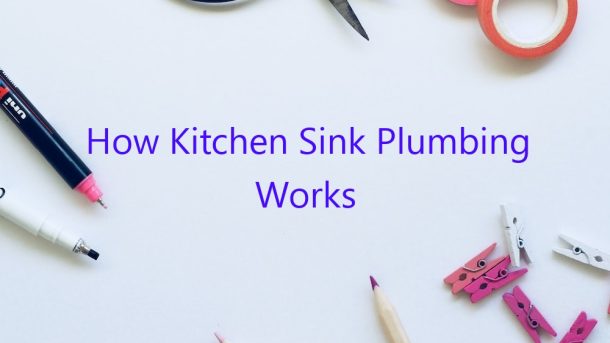The kitchen sink is one of the most important parts of a home, and it’s important to understand how it works. Kitchen sink plumbing can be confusing, but this guide will help you understand it.
The sink is attached to a main water line that goes to the house. This line carries cold water to the sink. When you turn on the faucet, the water pressure from the main line forces water through the faucet. The water flows through the sink and down the drain.
The drain in the sink is connected to a drain line that goes to the sewer or septic system. This line carries the dirty water away from the sink. The drain line is connected to a trap, which is a curved section of pipe that holds water. This water blocks the bad smells from the sewer or septic system from coming into the house.
There are also a number of other things that can go wrong with kitchen sink plumbing. If the sink is clogged, you can use a plunger to try to clear it. If the clog is too stubborn, you may need to use a plumbing snake to clear it.
If the water isn’t flowing correctly, you may need to adjust the water pressure from the main line. You can do this by adjusting the water shut-off valve.
It’s important to understand how your kitchen sink works so that you can troubleshoot any problems that may occur. With a little bit of knowledge, you can handle most problems on your own.
Contents
Does kitchen sink drain to sewer line?
The kitchen sink drain goes to the sewer line. The wastewater from the kitchen sink and other fixtures in the house flow through the pipes and eventually end up in the sewer line. This is the case for both homes that are connected to a municipal sewer system and those with a septic system.
Where does the water from the kitchen sink go?
Where does the water from the kitchen sink go? The water goes down the drain and is carried away to a wastewater treatment plant.
The wastewater treatment plant cleans the water and sends it back into the environment. The plant removes pollutants and harmful chemicals from the water.
How do sink pipes connect?
When you’re installing a sink, one of the decisions you’ll need to make is how the sink’s drainage will be connected to the main drainage pipe. This article will explain the different ways that this can be done.
The most common way to connect a sink’s drainage to the main drainage pipe is to use a P-trap. This is a U-shaped pipe that is installed under the sink. The two ends of the P-trap are connected to the sink’s drainage and the main drainage pipe.
Another way to connect a sink’s drainage to the main drainage pipe is to use a S-trap. This is a pipe that is installed above the sink. The end of the S-trap is connected to the sink’s drainage and the main drainage pipe.
Both the P-trap and the S-trap are effective ways to connect a sink’s drainage to the main drainage pipe. However, the P-trap is more common, because it is easier to install.
What are the 3 holes in the sink for?
There are three common sinkholes that are often found in sinks – the overflow hole, the drain hole, and the faucet hole. The overflow hole is located on the top of the sink and is used to release excess water when the sink is full. The drain hole is located at the bottom of the sink and is used to drain the water from the sink. The faucet hole is located on the side of the sink and is used to connect the faucet to the sink.
Does the sink drain into the same pipe as the toilet?
When it comes to plumbing, it’s important to know which fixtures drain into which pipes. This is because you don’t want to accidentally pour dirty water down the sink when you could be flushing it down the toilet. So does the sink drain into the same pipe as the toilet?
The answer to this question is…it depends. In some cases, the sink and the toilet both drain into the same pipe. In other cases, the sink drains into a different pipe than the toilet. It all depends on the layout of your home’s plumbing system.
So what’s the best way to find out if the sink and the toilet drain into the same pipe in your home? The best way to find out is to consult your home’s plumbing diagram. This diagram will show you the layout of your home’s plumbing system, including which pipes the sink and the toilet drain into.
If you don’t have a plumbing diagram for your home, you can ask a plumber to come and take a look at your plumbing system. They will be able to tell you which pipes the sink and the toilet drain into.
If you’re looking to install a new sink or toilet, it’s important to know which pipes the new fixture will be draining into. This will help you choose the right fixture for your home.
So does the sink drain into the same pipe as the toilet? In some cases, it does. In other cases, it doesn’t. It all depends on your home’s plumbing system. To find out for sure, consult your home’s plumbing diagram or ask a plumber.
Is the toilet drain connected to the sink drain?
When you are cleaning your bathroom, it is important to know which drains are connected. In particular, you may want to know if the toilet drain is connected to the sink drain.
The answer to this question is yes, the toilet and sink drains are usually connected. This means that anything that goes down the sink drain can also end up in the toilet. This can be a problem if you are trying to avoid clogs in your drain.
There are a few ways to prevent this from happening. One is to install a sink stopper. This will prevent anything from going down the sink drain. Another option is to install a trap on the sink drain. This will catch any debris before it can make it to the toilet.
If you are having problems with your drains, it is a good idea to have them inspected by a professional. They can tell you if the toilet drain is connected to the sink drain and what can be done to fix the problem.
Is kitchen drain connected to toilet?
The drainage systems in many homes are connected, meaning that the kitchen sink drain and the toilet drain are connected. This is not always the case, and some homes have separate drainage systems for the kitchen and the bathroom, but it is more common for the two drains to be connected. There are a few reasons why the kitchen sink and the toilet might be connected.
One reason is that it is simply more efficient to have one drain system for both the kitchen and the bathroom. Having two separate systems can be more costly and can also lead to drainage problems in one or both of the rooms. Another reason the two drains might be connected is that, in older homes, the drainage system was often installed when the home was built. If the home was built before the days of indoor plumbing, it is likely that the kitchen sink and the toilet were both connected to the same drainage system.
Whether or not the kitchen sink and the toilet are connected, it is important to remember that they should not be used as one another’s drainage system. The toilet should never be used to dispose of food waste or other materials that should not be going down the drain. Similarly, the kitchen sink should never be used to dispose of toilet paper or other materials that should not be going down the drain.
If you are unsure whether or not your kitchen sink and toilet are connected, you can check by removing the drain cover from the sink and looking down the drain. If you see a pipe that goes from the sink to the toilet, then the two drains are connected. If you do not see a pipe connecting the two drains, then the two drains are not connected.




